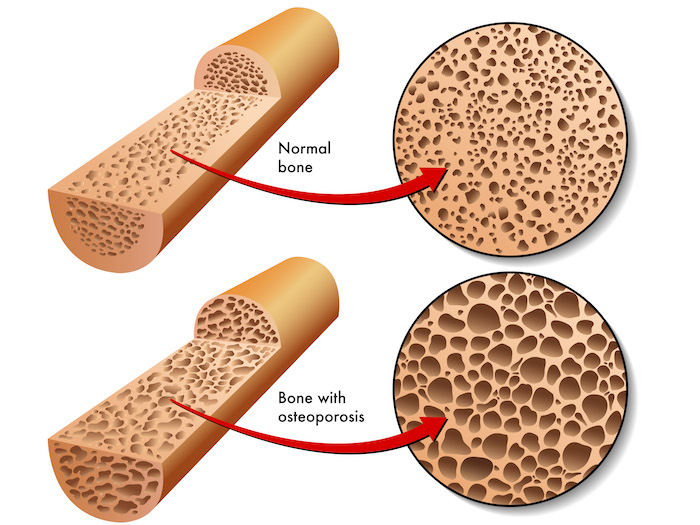What is osteoporosis?
Osteoporosis is characterised by low bone mass (sometimes referred to as low bone mineral density) and destruction of the bone tissue at a microscopic level (micro-architectural deterioration), which subsequently leads to bone fragility and an increased risk of bone fractures.1


The burden of osteoporosis in Australia
Based on recent evidence, the prevalence of osteoporosis (both known and unknown) in Australia among those above 50 years of age was estimated to be 23% for females and 6% for males. However, it is difficult to determine the true prevalence because osteoporosis has no obvious symptoms until a minimal trauma fracture occurs (eg. a fracture from falling over from standing height or lower).3
Hip fracture as a result of minimal trauma is one of the most serious outcomes of osteoporosis. A recent study showed nearly 20,000 people aged above 50 were hospitalised with a hip fracture over the period of one year, of whom more than 70% were aged above 80.3
How to prevent osteoporosis
The aim of osteoporosis prevention is not just to maintain bone mass, but to also reduce the overall risk of fracture.1
Diet and lifestyle
The following diet and lifestyle prevention actions are recommended to prevent osteoporosis, particularly for postmenopausal women and men over 50 years of age:2
- Adequate consumption of calcium: The recommended daily intake is 1300mg for women older than 50 and men aged above 70, and 1000mg for men aged 50-70. The richest sources of calcium are dairy foods – milk, cheese and yoghurt;
Foods high in calcium are recommended for osteoporosis. - Adequate and safe exposure to sunlight: Although some vitamin D can be found in our diet (fish, eggs, liver etc.), the main source of vitamin D is through exposure to sunlight. It is important to find the right balance for the amount of time spent under the sun – excessive sun exposure can be harmful and increases the risk of skin cancer;
- Maintain a healthy body mass index (BMI): A low body mass index is a known risk factor for fracture. Weight control guidance should be sought by a health professional as it is important to balance an individual’s status and risk of issues associated with being overweight and obese (such as diabetes and heart disease) with their risk of osteoporotic fracture;
- Cessation of smoking: Smoking is a well-known risk factor for osteoporosis, with there being a potential direct effect of cigarette smoke toxins on bone metabolism.
- Avoid excessive alcohol intake: Excessive alcohol consumption is associated with increased fracture risk, with the risk being slightly higher in men than women.
Exercise
Certain exercises – particularly regular weight-bearing, resistance and balance exercises – are recommended to prevent osteoporosis, as well as to prevent falls and reduce the risk of fracture.1 All individuals over the age of 50 without osteoporosis should aim to participate regularly (at least twice a week) in the following types of exercises:2
- Exercises for increasing bone mass: High-impact activities (eg. jumping, skipping) and strength training have been shown to be the most effective for increasing bone mineral density. High-impact activities should only be considered in individuals with no underlying problems such as joint or balance problems and who have a low fracture risk.
- Exercises to promote balance and prevent falls: Medium-to-high intensity balance training (ie. activities that are undertaken while standing and that challenge balance) are recommended when appropriate. Examples include tai-chi, standing on one leg, standing with feet close together, and walking backwards.

Visiting your GP
Visiting your GP is an important component of osteoporosis and osteoporotic fracture prevention. Some of the strategies and activities that your GP might undertake include:1
- assess any risk factors that you might have and suggest suitable prevention actions in light of these;
- help to further educate and inform you about osteoporosis and its complications;
- connect you with appropriate psychosocial support for risk factor modification;
- discuss important falls reduction and fracture risk reduction strategies;
- calculate your absolute risk of fracture, and if necessary, organise routine bone mineral densitometry testing.
There is a gradual transition from prevention to treatment with advancing age; therefore, your GP might also consider certain medications that will help to manage osteoporosis and prevent its complications.2
References
Royal Australian College of General Practitioners. Guidelines for preventive activities in general practice. 9th edn, updated. East Melbourne, Vic; RACGP, 2018.
The Royal Australian College of General Practitioners and Osteoporosis Australia. Osteoporosis prevention, diagnosis and management in postmenopausal women and men over 50 years of age. 2nd edn. East Melbourne, Vic; RACGP, 2017. Available from: URL link
Australian Institute of Health and Welfare (online). Estimating the prevalence of osteoporosis in Australia [accessed 2 Jan 2019]. Available from: URL link
All content and media on the HealthEngine Blog is created and published online for informational purposes only. It is not intended to be a substitute for professional medical advice and should not be relied on as health or personal advice. Always seek the guidance of your doctor or other qualified health professional with any questions you may have regarding your health or a medical condition. Never disregard the advice of a medical professional, or delay in seeking it because of something you have read on this Website. If you think you may have a medical emergency, call your doctor, go to the nearest hospital emergency department, or call the emergency services immediately.









